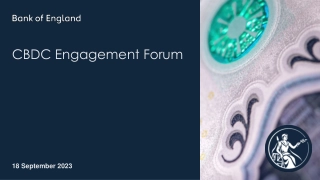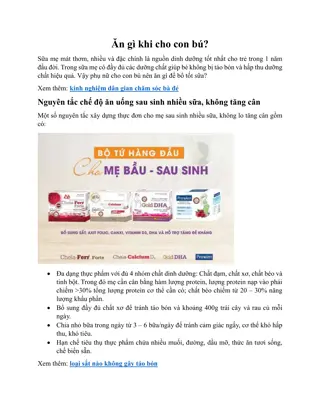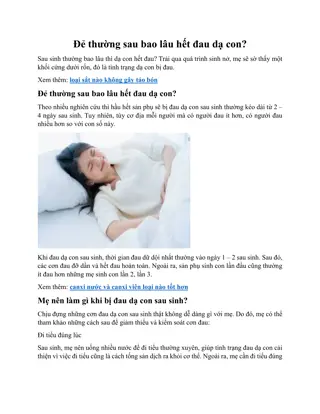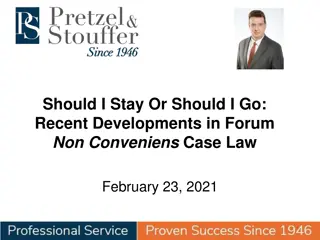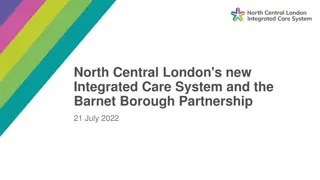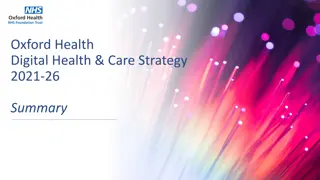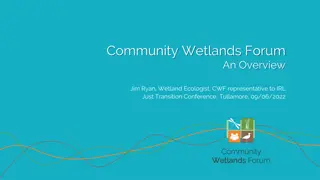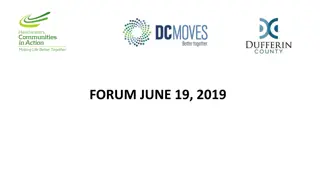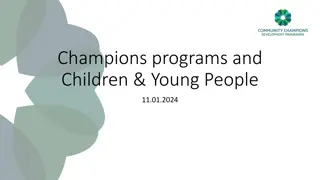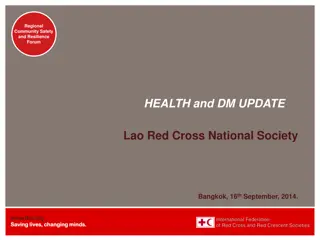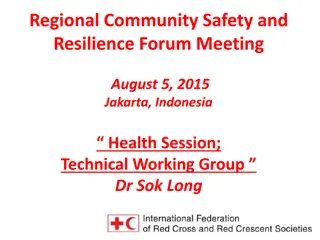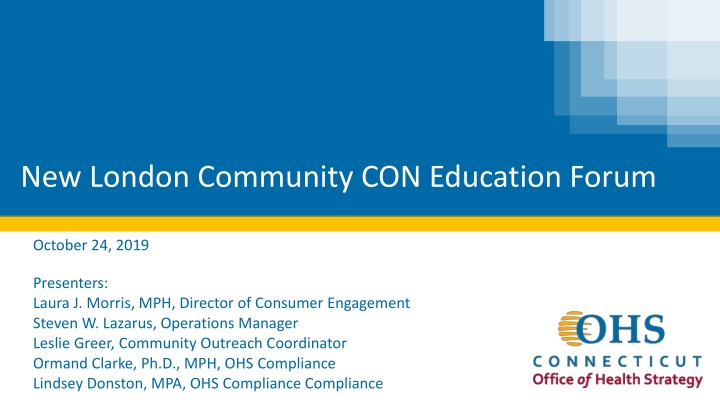
New London Community CON Education Forum: Health Strategy & Innovation
The New London Community CON Education Forum highlights the mission and vision of Connecticut's Office of Health Strategy (OHS), focusing on promoting equal access to high-quality healthcare and driving healthcare reform initiatives. Learn about the history of OHS, its values, and the collaborative efforts of its teams to analyze healthcare systems and policies for better health outcomes.
Download Presentation

Please find below an Image/Link to download the presentation.
The content on the website is provided AS IS for your information and personal use only. It may not be sold, licensed, or shared on other websites without obtaining consent from the author. If you encounter any issues during the download, it is possible that the publisher has removed the file from their server.
You are allowed to download the files provided on this website for personal or commercial use, subject to the condition that they are used lawfully. All files are the property of their respective owners.
The content on the website is provided AS IS for your information and personal use only. It may not be sold, licensed, or shared on other websites without obtaining consent from the author.
E N D
Presentation Transcript
New London Community CON Education Forum October 24, 2019 Presenters: Laura J. Morris, MPH, Director of Consumer Engagement Steven W. Lazarus, Operations Manager Leslie Greer, Community Outreach Coordinator Ormand Clarke, Ph.D., MPH, OHS Compliance Lindsey Donston, MPA, OHS Compliance Compliance
The mission of Connecticuts Office of Health Strategy is to implement comprehensive, data driven strategies that promote equal access to high-quality healthcare, control costs, and ensure better health outcomes for the people of Connecticut.
Our Vision We are looking to the future. Working together, we can find the best solutions to the challenges we face in health and healthcare cost, access, quality, equity and present those options to our state policymakers and stakeholders.
At OHS, we analyze healthcare systems and policies in the United States and in Connecticut, and we guide Connecticut to develop the best practices and best healthcare system for our state. We do this through our Health Data & Analysis, Health Innovation & Strategy and Health Systems Planning teams.
OHS History Pursuant to CGS 19a-754, as amended by Public Act 18-91, the Office of Health Strategy (OHS) was created in 2017 and established in 2018 by a strong bipartisan effort of the CT General Assembly to forward high-quality, affordable, and accessible healthcare for all residents. The legislation re-organized existing state resources into one body, centralizing health policymaking and advancing healthcare reform initiatives that will drive down healthcare costs, close Connecticut s deeply entrenched racial, economic, and gender health disparities, and undertake technology-driven modernization efforts throughout the system. The work of the Office of Health Strategy is funded, in part, by federal grants secured through a competitive process, placing Connecticut among states leading the way in health care policy reform. No new positions were created in the establishment of OHS; existing state resources are being deployed in a new, more efficient and effective way.
Office Of Health Strategy Health Innovation & Strategy Together we are the Office of Health Strategy in Connecticut. Health Data & Analysis Health Systems Planning Office of Health Strategy
Designing an innovative health system for CT Establish a whole patient centered system. Improve community health and eliminate obstacles that limit the highest quality care to everyone regardless of race, ethnicity, language or any other factor. Ensure quality, access and a superior care experience. Create payment models that help providers offer the most integrated holistic care. Improve affordability by reducing healthcare costs.
HealthInnovation & Strategy Develop state-led, multi-payer healthcare payment and service delivery reforms Provide technical assistance to providers to support participation in model reforms Develop and promote health insurance and coverage innovations that remove financial barriers to, or introduce rewards for healthy behavior, preventative care, medication adherence, chronic disease management, and use of high-value service and providers Develop innovations for the management and financing of cross-sector community initiatives to improve health; Promote healthcare workforce innovations Community Health Worker Initiative
Patients need to be empowered to participate in their own health and health care.
Tracking the quality of health care We all want to know where to find the highest quality care at the fairest price. We provide a website where you can find information about the quality of care that health systems provide across Connecticut. Visit www.healthscorect.com 14
We use data and policy ideas to improve health and contain the cost of health care for everyone in Connecticut.
Medical Records and Information Have you ever moved an elderly person to long term care and had to figure out all the medications they were taking? had difficulty transferring your medical records to a new doctor? had challenges ensuring your primary care doctor and specialists had the same up-to-date facts on your treatment? been concerned that an emergency room doctor had access to critical medical information in case of an accident?
Medical Records and Information You need access to medical records and information and your health care provider needs them too. Our Health Data & Analytics Team are working on a solution we re keeping a map of care that points to where medical records are created and stored so you and your providers can find and use them anywhere in CT.
Using data to shape policies We take the most up-to-date information about health and health care and analyze it in useful ways to deliver better health care in CT. TheAll Payers Claims Database (APCD), is an important source of Connecticut data that we use. Our data contain facts and statistics about how people use hospitals and health care providers, what types of services are provided, how much health care costs and the quality of health care available. We use these data to make evidence-based recommendations about improving our health care system in Connecticut.
Health Data & Analysis Create and administer a state Health Information Exchange Establish and administer the Core Data Analytics Solution (CDAS) toenable in-depth data analytics, including electronic Clinical Quality Measures (eCQMs) to support payment and practice reforms. Administer the All-Payer Claims Database (APCD) program for the purpose of collecting, assessing and reporting health care information. Prepare the statewide Health Information Technology Plan (HIT Plan) to achieve the state's health information technology goals. Medication Reconciliation and Polypharmacy work group is achieving stability and management solutions for patients who have many, multiple medications.
Health Systems Planning Activities Certificate of Need Acute Care and Specialty Hospitals Annual Financial Data Filings, Audited Financial Statements, Organizational Charts, etc. Utilization data collection (Inpatient, Outpatient and Emergency Department). Inventory of health care services, facilities and imaging equipment (Bi-Annually) Standard Publications: Acute Care Hospitals Financial Stability Report, (Annually), and Connecticut s Health Care Facilities and Services Plan (Bi-Annually)
What is a Certificate of Need and what does it do? Certificate of Need (CON) process regulates, monitors and improves Connecticut s health care system. CON deliberations and public hearings are an Office of Health Strategy s (OHS) regulatory responsibility that ensure that a health care facility and service development address the needs in our communities. The CON process protects the accessibility of healthcare services for consumers while limiting duplication of excess capacity of facilities and services in any given geographical area. OHS holds public hearings and encourages residents to give input on every CON application.
What Requires a CON? 19a-638 C.G.S. 1. 2. 3. Est. of a new health care facility (HCF) Transfer ownership of a HCF Transfer ownership of a large Group Practice Est. of a Free Standing ED Termination of a service (hospital) Est. of an O/P Surgical Facility Termination of a surgical services by an O/P (exemptions may apply) 8. 9. 10. Acq. of CT, MRI, PET, PET-CT, 11. Acq. Of nonhospital LinAc 12. Increase in lic. bed capacity of a HCF 13. Acq. Of new tech. equip. (1st in State) 14. An increase of 2 or more ORs in 3 yrs 15. Termination of I/P, O/P services by any facility that is eligible for Medicare or Medicaid Termination of an ED by a hospital Est. of cardiac services 4. 5. 6. 7.
How many and what type of CON applications are filed each year? Last year, 31 applications were filed with OHS: 10 for Termination of Service, 7 for Changes of Ownership (OSF/ASC, Group Practice), 5 for acquisition of imaging equipment, 5 for behavioral health. Over the past 8 years, annual CON applications filings have averaged approx. 28-30 new filings per year.
Who is part of the CON process? Applicant(s) Other providers (opposing or supporting the application/proposal) Applicant(s) Employees Public/Consumers/Community Legislators Media Local Municipalities Other States (Not directly but indirectly)
Opportunities for Engagement by Public/Consumers/Communities Public comments are accepted anytime by OHS. (Once application is filed all public comments become part of the file) Public has right to request a public hearing (Company representing 3 or more individuals or 5 or more individuals from public). At a public hearing, general public can provide comment to OHS (written, oral or both). Related statutory criteria, 19a-639 C.G.S.
OHS Current Efforts to Engage Public/Consumers/Community Notice upcoming hearing in the region s major newspaper(s). Post public hearing information on our website. Hearing information is disseminated via social media via (Twitter & Facebook). OHS relay s information to local town halls, public libraries and any public associations, that we may be aware of
OHS Current Efforts to Engage Public/Consumers/Community (Continued) OHS Outreach Coordinator plays a pivotal role between OHS and public Dedicated email for public comment (concomment@ct.gov ) Video recording of our public hearings on OHS YouTube Channel (Public Hearings recorded on and posted within 24 hours)
OHS Current Efforts to Engage Public/Consumers/Community (Continued) A newly developed Public Hearings Page on our website (one-stop-shop) OHS has a significant presence at its hearings. This provides public attending a direct person to ask questions regarding the application, hearing and process as well as submit information to OHS If an issue is brought up by public that has not yet been addressed, OHS will have the Applicant(s) address it directly at the hearing, while the public is present in the audience
OHS Current Efforts to Engage Public/Consumers/Community (Continued) Some examples of public engagement s effects on CONs: Development of Portals, since Sept 2017 (CON, HRS, Notifications/Filings) Hearings starting later in the day and OHS hearing staff present at least until 6 pm Hearings being adjourned (not closed the day of) to provide ample time for comments on record
New Londons Community Concerns from Public Hearing How will the affiliation between L+M and YNHHS help serve the greater New London community? How was the community involved in the Community Health Needs Assessment? Will members of the community be involved in decision making if essential services are no longer provided @ L+M? How will L+M remain connected to its community as a resource for health care? Termination of services @ L+M Relocation of services routed to YNHHS leaving fewer specialist at L+M Mistrust issues with hospital and decision makers Transportation to outpatient appointments Commitment to the Community Health Needs Assessment
Examples of OHS Conditions (Community Related) In certain CON decisions, here are some examples of conditions included in an Agreed Settlements: Public forums Community member on local boards Independent monitors Cost and Market Impact Review Requirement to develop and participate in local Community Health Needs Assessments/Reports, and Requiring an increase in Hospital Community Benefits
Conditions from L&M Change of Ownership (to Yale) CON Agreed Settlement Conditions cover the follow areas: Standard Conditions (submit Closing docs., legal agreements etc.) Inclusion of Community Member Joint Board Meetings & Public Forums Independent Monitor Data and Data Analysis (Related to Cost, Quality, Utilization, Financials) Services and Strategic Planning Community Benefits Cost and Market Impact Review
L & M Community Health Needs Assessment Priorities L & M Hospital s affiliation with Yale (Health System) began in September, 2016 2 Community Health Needs Assessment (CHNA) & Community Health Implementation Plans (CHIP) Former (2016-2019) and Current (2019- 2022) L+M and Ledge Light Health District composed the CHNA Click here for L & M s 2016 & 2019 CHNA s and Service Plans
Community Health Need (Per 2016-2019 CHNA & CHIP) Opioid Use LatinX Mental Health Healthy Lifestyles Asthma Maternal Child Health Cancer Access to Care Social Determinants Other Community Benefit Activities Health Professions Education Subsidized Health Services
Grand Total Community Benefits & Community Building FY 2016: $38,686,420 *FY 2017: $48,408,718 FY 2018: Available November 2019 o *Increase of $9,722,298 or 25% between FY 2016 & 2017 Note: The 2018 Community Benefits/Community Building Initiatives report is to be filed with OHS in the Nov., 2019 comprehensive report.
Community Health Need (Per 2019-2022 CHNA & CHIP) Chronic Diseases Hypertension Maternal Child Health Injury and Violence Environmental Risk Factors and health Access to Care Cancer Mental Health & Substance Abuse Infectious Diseases
Charity Care Policies FY2016 FY2017 FY2018 $3,555,323 $9,167,324 $10,256,156
L+M Physicians Group L+M Physicians are now New England Medical Group (NEMG) Physicians No conversion of any L+M physician offices to hospital-based status
Community Input, During and Post Compliance During compliance period (proposal specific): Independent Monitor OHS Outreach Coordinator (OHS Consumer Engagement) OHS Compliance Unit Post compliance period (over the hospital and health system): Access via OHS Outreach Coordinator (OHS Consumer Engagement) OHS, oversight through its statutory authority (19a-638 & 19a-639 C.G.S.) Examples: CON Modifications, OHS Inquiries, CON Determinations and CON Application Process.
New London Area Community Feedback At this point, OHS would like to ask for your feedback What has been your experience since the change of ownership has occurred? Services been maintained, improved, deteriorate, reduced (provide specific examples)? Access to healthcare? Physicians, Primary Care Services, etc. (examples) Location of services? Same, relocated, changed names etc. (examples) Other (Communication with community members, public forum, local board, etc.)
Leslie M. Greer Community Outreach Coordinator Mailing Address: 450 Capitol Avenue, MS#51OHS, P.O. Box 340308, Hartford, CT 06134-0308 Physical Address: 450 Capitol Avenue, 1st Floor, Hartford, CT 06106 Phone: 860-418-7013 leslie.greer@ct.gov(email)


